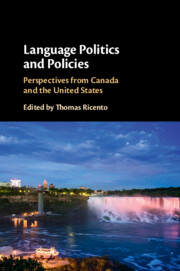Book contents
- Language Politics and Policies
- Language Politics and Policies
- Copyright page
- Dedication
- Contents
- Figures
- Tables
- Contributors
- Preface
- Contributor Personal Statements
- Introduction
- Part I Theoretical Orientations
- 1 The Liberal Tradition in America
- 2 The Political Ethics of Linguistic In-Betweenness
- 3 Alienation, Language Work, and the So-Called Commodification of Language
- 4 Canadian Language Politics in Global and Theoretical Contexts
- Part II The United States Context
- Part III The Canadian Context
- Index
- References
1 - The Liberal Tradition in America
A Historical-Institutionalist Approach to US Language Policy
from Part I - Theoretical Orientations
Published online by Cambridge University Press: 18 July 2019
- Language Politics and Policies
- Language Politics and Policies
- Copyright page
- Dedication
- Contents
- Figures
- Tables
- Contributors
- Preface
- Contributor Personal Statements
- Introduction
- Part I Theoretical Orientations
- 1 The Liberal Tradition in America
- 2 The Political Ethics of Linguistic In-Betweenness
- 3 Alienation, Language Work, and the So-Called Commodification of Language
- 4 Canadian Language Politics in Global and Theoretical Contexts
- Part II The United States Context
- Part III The Canadian Context
- Index
- References
Summary
Using a historical institutionalist approach, I demonstrate how institutionalized norms stemming from the liberal tradition in America have informed its language regime by tracing the path dependency of language policy and the critical junctures when changing norms lead to policy shifts. In the early republic, liberal norms enshrined in the Constitution informed a minimalist language regime. At the turn of the 19th century, norms shifted to reflect rapid industrialization and mass immigration, informing attempts at restrictive language policies. At the critical juncture of the civil rights movement, the monolingual language regime was challenged by new norms of what constituted a liberal democratic society. Neoliberal norms of the Reagan presidency facilitated the success of the English-only movement in changing language policies at the state-level. Neoliberal cosmopolitanism of the new millennium re-introduced minimal multilingual policy initiatives. I conclude by suggesting that Trump’s election represents a shift to nationalist, albeit possibly illiberal, norms.
Keywords
- Type
- Chapter
- Information
- Language Politics and PoliciesPerspectives from Canada and the United States, pp. 27 - 44Publisher: Cambridge University PressPrint publication year: 2019



